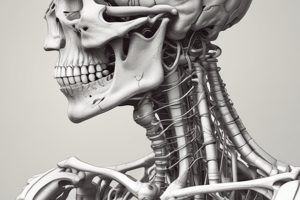Podcast
Questions and Answers
Which of the following describes syndesmoses?
Which of the following describes syndesmoses?
- Joints connected by fibrocartilage
- Joints connected by short ligaments (correct)
- Joints filled with synovial fluid
- Joints with irregularly shaped bone edges
What type of joint is a Gomphosis?
What type of joint is a Gomphosis?
- A joint connecting bones with hyaline cartilage
- A joint formed by interlocking irregular bone edges
- A joint that holds teeth in place (correct)
- A joint connected by short ligaments
What type of cartilage connects bones in synchondroses?
What type of cartilage connects bones in synchondroses?
- Hyaline cartilage (correct)
- Fibrocartilage
- Elastic cartilage
- Articular cartilage
Which characteristic is NOT typical of synovial joints?
Which characteristic is NOT typical of synovial joints?
Which type of synovial joint allows for rotational movement?
Which type of synovial joint allows for rotational movement?
What is the primary function of articular discs in synovial joints?
What is the primary function of articular discs in synovial joints?
Which movement decreases the angle between the origin and insertion of a muscle?
Which movement decreases the angle between the origin and insertion of a muscle?
During abduction, the body part moves in which direction?
During abduction, the body part moves in which direction?
What is the primary function of articulations in the body?
What is the primary function of articulations in the body?
How are fibrous joints characterized?
How are fibrous joints characterized?
Which type of joint classification primarily deals with joint movement capabilities?
Which type of joint classification primarily deals with joint movement capabilities?
Which of the following is NOT a type of functional joint classification?
Which of the following is NOT a type of functional joint classification?
If a joint is classified as diarthroses, what does this indicate about its movement?
If a joint is classified as diarthroses, what does this indicate about its movement?
Which of the following types of joints are primarily non-movable?
Which of the following types of joints are primarily non-movable?
What is the main distinguishing feature of synovial joints?
What is the main distinguishing feature of synovial joints?
During a lab quiz, what is a critical aspect to remember regarding electronic devices?
During a lab quiz, what is a critical aspect to remember regarding electronic devices?
Flashcards are hidden until you start studying
Study Notes
Articulations and Body Movements
- An articulation is a joint.
- Articulations are classified either structurally or functionally.
- Structurally joints are classified as fibrous, cartilaginous or synovial joints.
- Functionally joints are classified as synarthroses, amphiarthroses or diarthroses.
- Synarthroses are non-movable joints.
- Amphiarthroses are slightly movable joints.
- Diarthroses are freely movable joints.
Fibrous Joints
- Fibrous joints consist of bones held together by fibrous tissues.
- Most fibrous joints are synarthrotic or non-movable.
- Fibrous joints have no joint cavity.
- Types of fibrous joints are sutures, syndesmoses, and gomphoses.
- Sutures are joints with bones with irregular edges interlocked by short connective tissue fibers.
- Syndesmoses are joints with bones connected by short ligaments.
- A Gomphosis is a joint that holds the teeth in the mandible via the periodontal ligament.
Cartilaginous Joints
- Cartilaginous joints have articulating bones connected by plates or pads of cartilage.
- Cartilaginous joints have no joint cavity.
- Most cartilaginous joints are amphiarthrotic (slightly movable).
- Types of cartilaginous joints are symphyses and synchondroses.
- Symphyses are joints which have bones that are connected by a broad flat disc of fibrocartilage.
- Synchondroses are bones connected by hyaline cartilage.
Synovial Joints
- Synovial joints have bones separated by joint cavities filled with synovial fluid.
- Synovial joints are diarthrotic or freely movable.
- Characteristics of synovial joints:
- Articular Capsule: 2 layers - a fibrous capsule of dense irregular connective tissue and a layer of synovial membrane which secretes synovial fluid.
- Articular cartilage (hyaline) on the surfaces of the articulating bones.
- Ligaments (hold bones of joint together).
- Bursae (fluid filled sacs).
- Articular discs may be found (Meniscus), (padding between articulating bones).
- Types of synovial joints: plane or gliding, hinge, pivot, condyloid/ ellipsoidal, saddle, ball and socket.
Types of Body Movements
- The Origin is the point of attachment of muscle that is immobile.
- The Insertion is the point of attachment of muscle that moves.
- A Contraction of muscle causes the insertion to move towards the origin.
- Flexion decreases the angle between the origin and the insertion.
- Extension increases the angle between the origin and the insertion.
- Abduction is a movement away from the midline.
- Adduction is a movement towards the midline.
- Rotation is a movement around the long axis of a bone.
- Circumduction is a movement that makes an imaginary cone along the long axis of a bone.
Studying That Suits You
Use AI to generate personalized quizzes and flashcards to suit your learning preferences.




